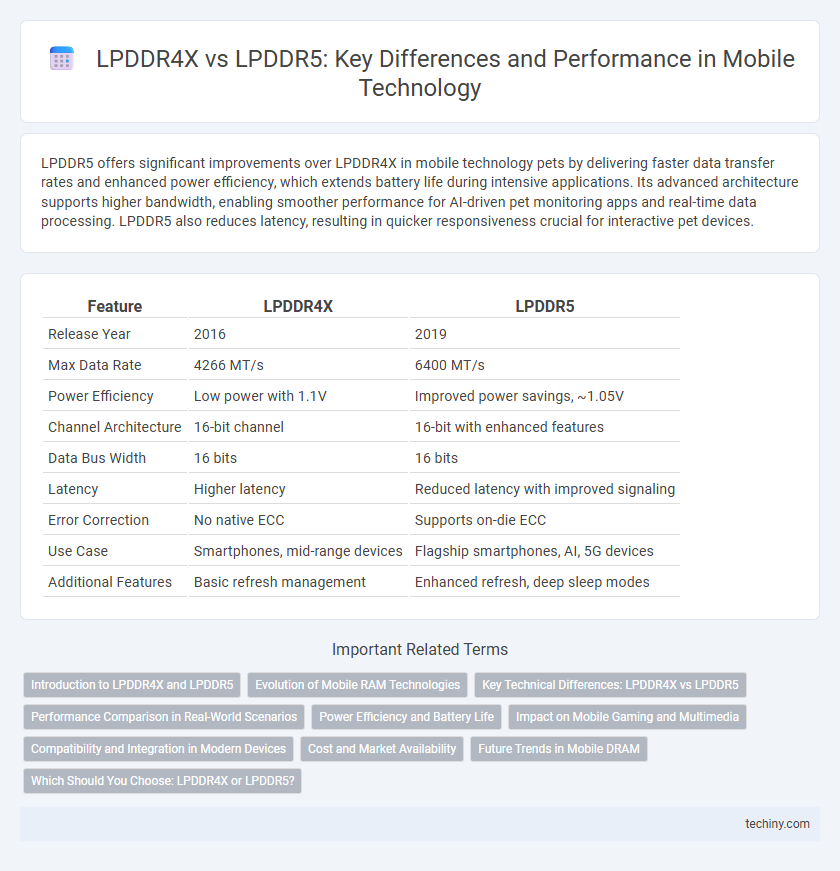LPDDR5 offers significant improvements over LPDDR4X in mobile technology pets by delivering faster data transfer rates and enhanced power efficiency, which extends battery life during intensive applications. Its advanced architecture supports higher bandwidth, enabling smoother performance for AI-driven pet monitoring apps and real-time data processing. LPDDR5 also reduces latency, resulting in quicker responsiveness crucial for interactive pet devices.
Table of Comparison
| Feature | LPDDR4X | LPDDR5 |
|---|---|---|
| Release Year | 2016 | 2019 |
| Max Data Rate | 4266 MT/s | 6400 MT/s |
| Power Efficiency | Low power with 1.1V | Improved power savings, ~1.05V |
| Channel Architecture | 16-bit channel | 16-bit with enhanced features |
| Data Bus Width | 16 bits | 16 bits |
| Latency | Higher latency | Reduced latency with improved signaling |
| Error Correction | No native ECC | Supports on-die ECC |
| Use Case | Smartphones, mid-range devices | Flagship smartphones, AI, 5G devices |
| Additional Features | Basic refresh management | Enhanced refresh, deep sleep modes |
Introduction to LPDDR4X and LPDDR5
LPDDR4X is a low-power DRAM technology designed to enhance mobile device efficiency by offering data rates up to 4266 MT/s and reduced power consumption compared to LPDDR4. LPDDR5 advances this with higher data rates up to 6400 MT/s, improved power management, and increased bandwidth, making it suitable for demanding applications like AI and 5G in smartphones. Both memory types aim to balance speed and energy efficiency, but LPDDR5 provides significant improvements for next-generation mobile technology performance.
Evolution of Mobile RAM Technologies
LPDDR5 offers significant improvements over LPDDR4X, delivering up to 50% higher data rates with speeds reaching 6400 Mbps compared to LPDDR4X's 4266 Mbps, enhancing mobile device performance and power efficiency. The evolution from LPDDR4X to LPDDR5 incorporates advanced features such as deep sleep power states and improved signal integrity, enabling better battery life and faster processing for smartphones and tablets. Mobile RAM advancements also prioritize reduced latency and increased bandwidth, supporting the growing demands of AI, 5G connectivity, and high-resolution multimedia applications.
Key Technical Differences: LPDDR4X vs LPDDR5
LPDDR5 offers significant improvements over LPDDR4X, including higher data transfer rates up to 6400 Mbps compared to LPDDR4X's 4266 Mbps, enhancing mobile device performance and power efficiency. LPDDR5 introduces features such as dynamic voltage scaling and improved bank group architecture, reducing power consumption and latency. The upgraded error correction capabilities in LPDDR5 improve data integrity, making it ideal for advanced applications in smartphones and laptops requiring faster memory speeds and lower power usage.
Performance Comparison in Real-World Scenarios
LPDDR5 outperforms LPDDR4X with up to 50% higher data transfer rates, reaching speeds of 6400 Mbps compared to 4266 Mbps in real-world mobile applications. This improvement enhances multitasking, gaming, and AI-driven tasks by reducing latency and power consumption by approximately 20%. Devices equipped with LPDDR5 memory demonstrate better battery efficiency and smoother performance under intensive workloads than those using LPDDR4X.
Power Efficiency and Battery Life
LPDDR5 offers significant improvements in power efficiency over LPDDR4X by incorporating data rates up to 6400 Mbps and advanced power management features like deep sleep and dynamic voltage scaling. These enhancements result in lower energy consumption per bit transferred, extending battery life in mobile devices such as smartphones and laptops. The transition from LPDDR4X's 4266 Mbps to LPDDR5's higher bandwidth also supports more efficient multitasking and AI processing without compromising battery longevity.
Impact on Mobile Gaming and Multimedia
LPDDR5 offers up to 50% higher data rates than LPDDR4X, significantly reducing latency and improving frame rates in mobile gaming. Enhanced power efficiency in LPDDR5 extends battery life during intensive multimedia tasks, such as 4K video playback and augmented reality applications. The increased bandwidth and faster random access speeds in LPDDR5 enable smoother multitasking and more responsive touch experiences compared to LPDDR4X.
Compatibility and Integration in Modern Devices
LPDDR5 offers enhanced compatibility with modern devices through optimized power efficiency and faster data rates compared to LPDDR4X, enabling seamless integration in high-performance smartphones, tablets, and laptops. Its improved signal integrity and backward compatibility with LPDDR4X standards facilitate easier adoption in diverse hardware ecosystems. Manufacturers prioritize LPDDR5 to support advanced features such as AI processing and 5G connectivity, ensuring future-proof mobile technology integration.
Cost and Market Availability
LPDDR4X memory modules generally offer a lower cost compared to LPDDR5, making them a favored choice for budget-conscious mobile device manufacturers. LPDDR5, while more expensive, delivers higher data rates and improved power efficiency, targeting premium smartphones and high-performance applications. Market availability for LPDDR4X remains vast due to its mature production cycle, whereas LPDDR5 is rapidly expanding in supply as demand grows in the flagship mobile segment.
Future Trends in Mobile DRAM
LPDDR5 offers significant improvements over LPDDR4X in mobile DRAM with higher data transfer rates reaching up to 6400 Mbps compared to 4266 Mbps in LPDDR4X, enhancing performance in 5G and AI applications. Future trends indicate widespread adoption of LPDDR5 for its lower power consumption and greater efficiency, supporting advanced mobile experiences and extended battery life. Emerging developments aim to integrate LPDDR5X and beyond, focusing on even higher bandwidth and reduced latency to meet growing demands in mobile computing and immersive technologies.
Which Should You Choose: LPDDR4X or LPDDR5?
LPDDR5 offers faster data rates up to 6400 Mbps compared to LPDDR4X's 4266 Mbps, enhancing performance in mobile devices with reduced power consumption. For high-end smartphones and gaming devices requiring improved multitasking and AI capabilities, LPDDR5 is the optimal choice. Budget or mid-range devices benefit from LPDDR4X's balance of efficiency and cost-effectiveness while still delivering reliable speed.
LPDDR4X vs LPDDR5 Infographic

 techiny.com
techiny.com